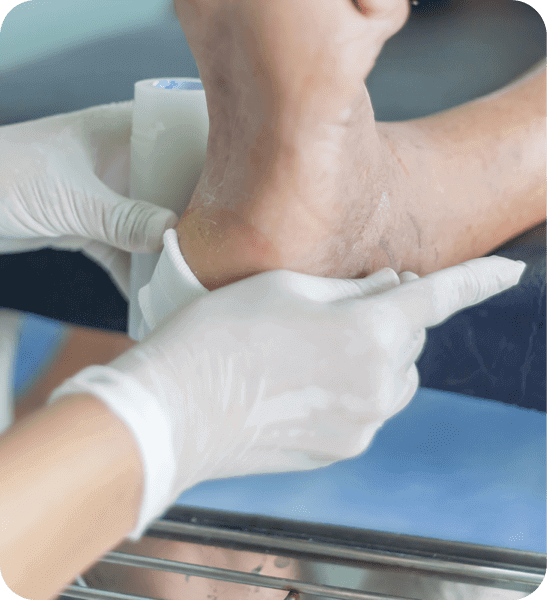Hyperbaric Oxygen Can Improve Rheumatoid Arthritis

How Hyperbarics Helps
Increases oxygen in the bloodstream 1,200% above normal
Dramatically decreases inflammation
Stimulates stem cell reproduction and mobilization
Relieves pain
What the Research Says
Hyperbaric Oxygen Therapy (HBOT) is being explored as a potential adjunctive treatment for Rheumatoid Arthritis (RA), a chronic inflammatory disorder characterized by joint pain, swelling, and eventual joint destruction. HBOT involves administering 100% oxygen at increased atmospheric pressures, which enhances oxygen delivery to tissues throughout the body. This increased oxygenation can help reduce hypoxia in inflamed joint tissues, potentially alleviating pain and promoting healing. By improving oxygen levels in these tissues, HBOT may help mitigate some of the pathological processes associated with RA, such as chronic inflammation and oxidative stress.
One of the significant benefits of HBOT in the context of RA is its anti-inflammatory effects. Inflammatory cytokines, which play a critical role in RA pathogenesis, can be modulated by the increased oxygen levels provided by HBOT. Research has shown that HBOT can reduce the production of pro-inflammatory cytokines and enhance the levels of anti-inflammatory cytokines, thereby helping to rebalance the immune response. This modulation of the inflammatory process can lead to a reduction in joint swelling and pain, improving the overall quality of life for RA patients.
HBOT also promotes tissue repair and regeneration, which are crucial for managing the damage caused by RA. The therapy enhances the function of fibroblasts, cells that are vital for collagen production and wound healing. By stimulating fibroblast activity, HBOT can aid in the repair of damaged joint tissues and the maintenance of cartilage integrity. Additionally, the increased oxygen levels can enhance angiogenesis, the formation of new blood vessels, which is essential for delivering nutrients and oxygen to healing tissues. These regenerative effects can help slow the progression of joint damage and support the recovery of joint function.
While the potential benefits of HBOT for RA are promising, it is essential to recognize that this application is still under investigation. Clinical trials are necessary to establish standardized treatment protocols, determine the long-term efficacy, and identify any potential risks or side effects associated with HBOT in RA patients. However, the current evidence suggests that HBOT could serve as a valuable complementary therapy for RA, especially for patients who do not respond adequately to conventional treatments. As research continues, HBOT may become an integral part of the therapeutic regimen for managing RA, providing hope for improved symptom control and better quality of life for patients.
Research Studies
This case series pilot study assessed the effects of hyperbaric oxygen therapy (HBO2) for treating rheumatoid arthritis (RA).
This case series pilot study assessed the effects of hyperbaric oxygen therapy (HBO2) for treating rheumatoid arthritis (RA).
The Effects of Hyperbaric Oxygen on Rheumatoid Arthritis
The Effects of Hyperbaric Oxygen on Rheumatoid Arthritis
Patient Experiences
-

Ruth, 68
Hyperbaric oxygen therapy significantly reduced Ruth's pain for the three years we stayed in contact.
Ruth was a retired school teacher, who loved volunteering as a docent at museums. However, her rheumatoid arthritis made simple tasks, such as picking up a piece of paper or writing, extremely painful and difficult. After 40 hyperbaric treatments, Ruth was virtually pain free and actually wept for joy at how she felt thirty years younger and was able to hike and return to her volunteer work!
-

Sam, 76
Hyperbaric oxygen therapy allowed Sam to continue to keep active by working as long as he wanted.
Sam loved working as a Runner for a contractor, and handling small jobs. It kept him feeling young and engaged. However, his arthritis made his hands look–as he said–like hooks, rather than hands. After two sets of 20 treatments, Sam was able to go back to work and feel like a productive member of society! It gave him his life back.
Physicians: Refer a Patient
You Submit Your Patient’s Information
We Get Authorizations
Patient Starts HBOT

Related Articles
Research on Hyperbaric Oxygen Therapy
-
What is Hyperbaric Oxygen Therapy?
Hyperbaric oxygen therapy treats medical conditions with 100% oxygen in a pressurized hyperbaric chamber. The patient lies or sits in the chamber. The oxygen then saturates the plasma in the blood, allowing oxygen to easily flow throughout the body and reach even areas that are injured or diseased, which typically receive less oxygen. The mechanisms of hyperbaric oxygen therapy include stimulating and mobilizing stem cells, down-regulating inflammatory genes, up-regulating reproductive cells and stimulating DNA. HBOT also regrows tiny blood vessels, and stimulates the growth of new healthy cells in the brain, bones, skin, organs, and tissues. People seek hyperbaric oxygen therapy to heal physical damage in their bodies and to promoting health and anti-aging.
-
Does HBOT kill cancer cells?
Current research indicates that hyperbaric oxygen does not kill cancer cells. However, there has been a small amount of research indicating that hyperbaric oxygen might reduce the size of certain tumors. Also, there has been a study on mice using hyperbaric oxygen, along with a ketogenic diet, to reduce tumors. Hyperbaric oxygen causes many different healing modalities to kick into gear. Could its effect on strengthening the immune system inhibit the growth of cancer cells? Nobody knows. There are numerous studies conclusively showing that hyperbaric oxygen does not encourage cancer cells or tumors to grow. Some patients claim the hyperbaric oxygen makes them feel a lot more comfortable and functional after chemotherapy and also during healing. Note that some chemotherapy drugs are not to be used with hyperbaric oxygen, as the chemotherapy drugs can be enhanced and thus become toxic. A good hyperbaric oxygen facility (such as Bay Area Hyperbarics) will always call the chemotherapy manufacturer to ensure that hyperbaric oxygen therapy will be helpful and not damaging to the patient.
-
IWhat is the CPT code for HBOT?
The CPT code for HBOT is G0277.
-
Does Medicare cover HBOT?
Medicare covers Hyperbaric Oxygen Therapy for approved conditions, and many insurance companies also cover approved conditions. If your condition is not approved by your insurance, we can discuss our special rates. Give us a call at (408) 356–7438. We are happy to discuss your options with you.
-
Can HBOT help Neuropathy?
Hyperbaric treatments help heal neuropathy by regrowing small blood vessels and nerves that have died from disease, injuries from radiation and aging. Patients often experience numbness and or pain when they start treatment. Hyperbaric treatments most often bring back sensation and make, for example, walking easier and more enjoyable.
-
Why would a physician consider HBOT?
A physician would consider using hyperbaric chamber therapy under a variety of situations. Physicians most typically refer patients to hyperbarics when the patient is not healing with traditional medical interventions and hyperbaric chamber therapy is approved by Medicare for this condition. Some patients experience significant unresolved pain and unremitting disease states that the mechanisms of hyperbaric oxygen therapy in a hyperbaric chamber are known to affect, such as the down regulation of inflamatory genes. For an example, some patients have experienced severe, unremitting hives with itching, which did not improve with any specialists interventions. Some physicians will consider hyperbaric chamber therapy if the patient has no other good avenues for improving their failing health, and they know the hyperbaric chamber therapy is safe and will not harm the patient.
-
What is Hypebaric Oxygen Therapy?
Hyperbaric Oxygen Therapy (HBOT) Hyperbaric Oxygen Therapy (HB0T) is a medical treatment where you inhale 100% oxygen in a chamber with increased atmospheric pressure. HBOT injects 400x the oxygen into your tissues and bones and mobilizes stem cells. It regrows healthy tissues in the brain, blood vessels, skin and bones. It also reduces pain and swelling, and speeds recovery. It is simple, effective and painless.
Have more Questions?




